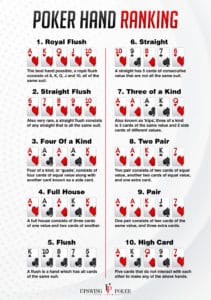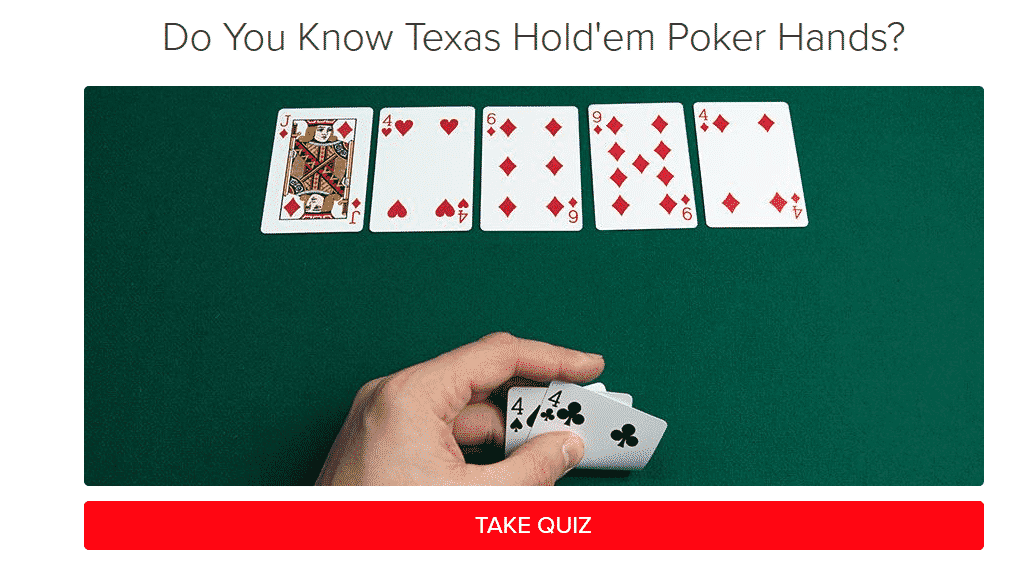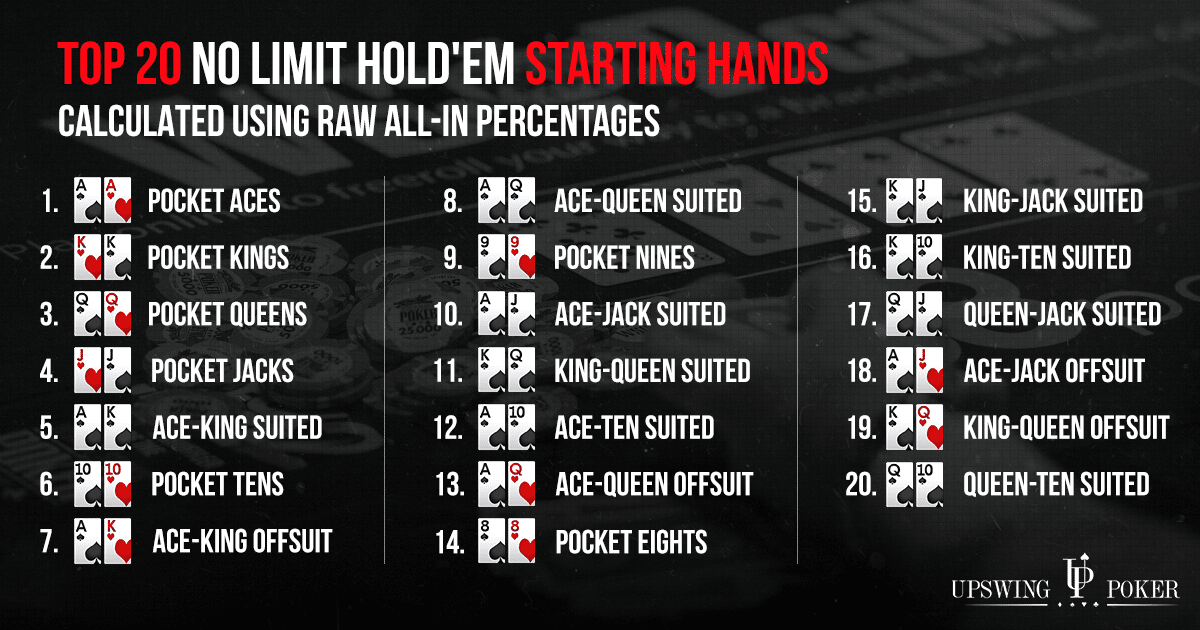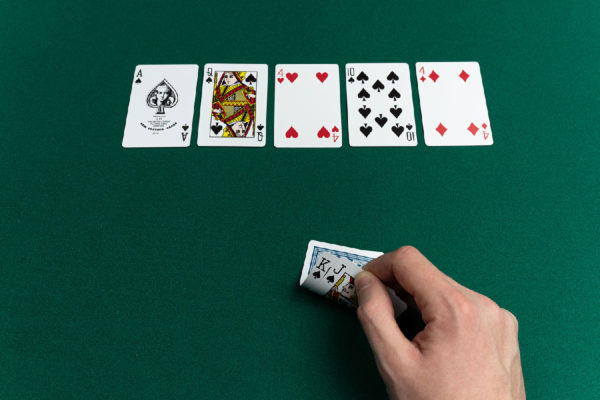
Poker Hand Rankings & The Best Texas Hold’em Poker Hands
The order of poker hand rankings (from the highest/best to the lowest/worst) is: Royal Flush, Straight Flush, Four-of-a-Kind, Full House, Flush, Straight, Three-of-a-Kind, Two Pair, One Pair, High Card.
Below you will find a list of poker hands in order from highest to lowest to help you get started, as well as the top starting hands for Texas Hold'em. There's also a quick quiz that will help you remember the hands next time you play poker.
Poker Hand Rankings
1. Royal Flush (A♦ K♦ Q♦ J♦ T♦)
The best hand possible, a royal flush consists of A, K, Q, J and 10, all of the same suit.
2. Straight Flush (T♥ 9♥ 8♥ 7♥ 6♥)
Also very rare, a straight flush consists of any straight that is all the same suit.
3. Four-of-a-Kind (J♦ J♣ J♠ J♥ K♦)
Four of a kind, or 'quads', consists of four cards of equal value along with another card known as a side card.
4. Full House (A♥ A♣ A♦ 9♠ 9♣)
A full house consists of three cards of one value and two cards of another.
5. Flush (A♠ J♠ 8♠ 4♠ 3♠)
A flush is a hand which has all cards of the same suit.
6. Straight (9♥ 8♠ 7♣ 6♦ 5♣)
A straight has 5 cards of consecutive value that are not all the same suit.
7. Three-of-a-Kind (7♠ 7♦ 7♣ K♦ Q♣)
Also known as 'trips', three of a kind is 3 cards of the same value and 2 side cards of different values.
8. Two-Pair (9♣ 9♦ 6♣ 6♠ Q♥)
Two pair consists of two cards of equal value, another two cards of equal value, and one extra card.
9. One-Pair (A♦ A♥ K♠ 9♦ 4♥)
One pair consists of two cards of the same value, and three extra cards.
10. High Card (A♠ J♦ 8♣ 6♠ 2♥)
High card is when you have five cards that do not interact with each other to make any of the above hands.
If you want to win at poker, you obviously need to know what hand you've been dealt and what hand wins. Take the first step to winning at poker and download these rankings here:
Hand Rankings Cheat Sheet Chart
Ready for a poker hands quiz?
Poker Hand Rankings Quiz
Put your knowledge of poker hands to the test with the quiz below. Good luck!
(The quiz will open in a new tab.)
Note: Want some strategic tips to help you win at poker? Check out these 10 Quick Poker Tips!
Tie-breakers and Kickers
When multiple players have the same poker hands, the extra cards come in to play. These extra cards are called 'kickers'. The player with the higher kicker will take the pot when this happens.
Texas Hold'em Example:
- Player A has K♥ 9♥
- Player B has A♠ K♦
- The flop, turn and river are K♠-T♣-T♦-4♠-2♣
This means the players' final five card poker hands are:
- Player A: K♥ K♠ T♣ T♦ 9♥ for Two Pair, Kings and Tens with a Nine kicker
- Player B: K♦ K♠ T♣ T♦ A♠ for Two Pair, Kings and Tens with an Ace kicker
Both players have a pair of kings, but the winner of the pot is Player B because he has Player A 'out-kicked'.
In a high card or one pair hand tie-breaker, both players can sometimes have the same kicker. In this case the second kicker is used, and then the third, and so on. If both players’ best five card poker hands are identical, then they share the pot equally.
Now, let's talk about starting hands in Texas Hold'em.
Note: Are you here just to learn how to play poker...or do you want to know how to win too? Get this free guide with 10 quick poker strategy tips if you want to come out on top.

Note: Are you here just to learn how to play poker...or do you want to know how to win too? Get this free guide with 10 quick poker strategy tips if you want to come out on top.

Ranking The Top 20 No Limit Texas Hold’em Starting Hands
I wanted to include something a bit more exciting in this article, so here's the top 20 No Limit Hold'em starting hands in terms of raw all-in equity (or percentages).
Although the order of the best poker hands to start with is sometimes contested, this list will give you a rough idea of which hands are stronger than others:
#1. Pocket Aces (A♠ A♥).
The very best starting hand in Texas Hold'em.
Fun fact: the hand with the highest odds of beating aces in a one-on-one match-up is 6-5 suited (22.51% vs 77.49%).
#2. Pocket Kings (K♠ K♣).
The second best starting hand. Kings are known as "ace magnets" by more pessimistically-minded players.
#3. Pocket Queens (Q♠ Q♥).
The ladies are the third best starting hand. This premium pair will be an overpair to the flop quite often. Starting to notice a trend?
#4. Pocket Jacks (J♠ J♥).
Also known as fishhooks, jacks are one of the most complained-about hands in poker. If you hate jacks, read 3 Tips to Stop Spewing with Pocket Jacks.
#5. Ace-King Suited (A♠ K♠).
The best non-pair is also known as big slick. Players often complain about missing flops with ace-king, so we wrote How to Play Ace-King When You Miss the Flop.
#6. Pocket Tens (T♠ T♥).
Back to pairs! Pocket tens are another premium pair with which you should often be willing to commit a lot of money. Make sure to proceed cautiously when facing a lot of action.
#7. Ace-King Offsuit (A♠ K♥).
A powerful hand that has at least a 45-50% chance to win versus almost any holding (with the exceptions being aces and kings).
#8. Ace-Queen Suited (A♠ Q♠).
Another premium hand with a lot of postflop playability. This hand hits many strong top pairs, and it's especially valuable on queen-high flops because you'll have top pair top kicker.
#9. Pocket Nines (9♠ 9♥).
A strong hand that is almost always worth playing preflop, whether it be by raising yourself, calling a raise, or 3-betting.
#10. Ace-Jack Suited (A♥ J♥).
Like ace-queen suited, ace-jack suited has a lot of postflop playability and hits a lot of strong top pairs on the flop. Not to mention it's flush and straight potential.
#11. King-Queen Suited (K♠ Q♠).
This hand has a lot of playability because of how well it interacts with flops. It can easily hit strong top pairs, plus straights and flushes.
#12. Ace-Ten Suited (A♥ T♥).
Like king-queen suited, this hand has a lot of playability with strong top pair, flush, and straight potential. However, the large gap between cards makes it slightly less preferable to king-queen suited.
#13. Ace-Queen Offsuit (A♠ Q♦).
Like its suited counterpart, ace-queen offsuit hits a lot of strong top pairs and is thus very valuable.
#14. Pocket Eights (8♣ 8♦).
The lowest pair that cracks the top 20 best No Limit Hold'em starting hands. Pocket eights are strong, but will often face tough spots when an overcard or two comes on the flop.
#15. King-Jack Suited (K♦ J♦).
Yet another top starting hand that hits strong top pairs relatively often -- sound familiar?
#16. King-Ten Suited (K♠ T♠).
Like many of the other hands on this list, king-ten suited has the potential to hit strong pairs, straights and flushes.
#17. Queen-Jack Suited (Q♦ J♦).
Can you guess what makes this hand strong? That's right: it can hit strong pairs, flushes, and straights.
#18. Ace-Jack Offsuit (A♣ J♠).
Another powerful, high-card-driven hand. Be somewhat wary with ace-jack on ace-high flops, especially versus tight players who may have ace-king and ace-queen.
#19. King-Queen Offsuit (K♥ Q♠).
Like it's suited counterpart, king-queen offsuit is great at hitting strong pairs on the flop. Plus, that A-J-T flop is soooo dreamy.
#20. Queen-Ten Suited (Q♠ T♠).
This high-potential suited broadway hand rounds out the list.
Note: You may have noticed a lack of small pocket pairs and suited connectors on this list. Such hands are often worth playing, but because of their more speculative nature, they do not crack the top 20 best starting hands in No Limit Texas Hold'em.
Which Poker Starting Hands Should You Play?
If you want to know which hands to play before the flop in No Limit Hold'em, and when to play them, download the free preflop guide below.
No Limit Texas Hold'em Free Starting Hands Charts
Note: If you want to win at poker, you need a solid preflop strategy. This free Preflop Guide includes 8 easy-to-read charts and crucial tips that will help you play like a pro before the flop. Get it now!

This guide will show you exactly which hands to raise from each position before the flop. It also includes the answers to some preflop questions that many new poker players ask about.
Poker Hand Rankings FAQ
How many poker hands are there?
There are 10 possible 5 card poker hands: royal flush, straight flush, four of a kind, full house, flush, straight, three of a kind, two pair, one pair, high card.
There are 1,326 possible 2 card starting hands in Texas Hold'em. The best starting hand is pocket aces, while the worst is seven-two offsuit.
Is three pair a poker hand?
No, three pair is not a poker hand. Poker hands consist of 5 cards, not 6.
For example, if you have 7-6 and the board runs out 7-6-A-A-2, you do not have three pair. You have two pair, aces and sevens with a six kicker.
What's the best hand in poker?
Poker's best hand is a royal flush, which consists of an Ace, King, Queen, Jack, and Ten of the same suit.
Royal flushes are unbeatable and extremely rare.
What are the odds of getting a royal flush?
The odds of flopping a royal flush in Texas Hold'em in any given hand is 1 in 649,740 (before cards are dealt). That's less than a 0.000002% chance!
If you have a suited hand with two high cards (like Q♠ J♠), you have a 1 in 19,600 chance of hitting a royal flush on the flop.
What is a straight flush?
A straight flush is five cards in a row of the same suit. For example, 9♠ 8♠ 7♠ 6♠ 5♠ is a straight flush.
What are the odds of getting a straight flush?
The odds of flopping a straight flush in any given hand is 1 in 72,193 (before cards are dealt). That comes out to 0.000013%.
If you get dealt a specific type of hand, those odds get a fair bit better. But it's still quite a long shot!
Suited connectors with no gaps like 54s and JTs have a 1 in 4,900 chance of hitting a straight flush on the flop. Those sound like long odds, but they'll seem a bit shorter when you read that suited connectors with gaps (like 84s) have just a 1 in 19,600 chance.
What are the odds of getting four-of-a-kind?
The odds of flopping four-of-a-kind in any given hand is 1 in 4,165 (before cards are dealt). That comes out to 0.02401%.
If you get dealt a pocket pair, those odds get a fair bit better.
Pocket pairs like A♠ A♣ have a 1 in 407 chance of hitting four-of-a-kind on the flop.
What are the odds of getting a full house?
The odds of flopping a full house in any given hand is 1 in 694.1 (before cards are dealt). That comes out to 0.1441%.
What are the odds of getting a flush?
The odds of flopping a flush in any given hand is 1 in 508.8 (before cards are dealt). That comes out to 0.1965%.
If you get dealt two suited cards, those odds get a fair bit better.
Suited cards like A♠ K♠ have a 1 in 118 chance of hitting a flush on the flop.
What are the odds of getting a straight?
The odds of flopping a straight in any given hand is 1 in 254.8 (before cards are dealt). That comes out to 0.3925%.
If you get dealt two connected cards, those odds get a fair bit better.
Connected cards like 9♠ 8♣ have a 1 in 77.5 chance of hitting a straight on the flop.
What are the odds of getting three-of-a-kind?
The odds of flopping three-of-a-kind in any given hand is 1 in 47.3 (before cards are dealt). That comes out to 2.1128%.
If you get dealt a pocket pair, those odds get a fair bit better.
Pocket pairs like K♣ K♠ have a 1 in 7.5 chance of hitting three-of-a-kind on the flop.
What are the odds of getting two-pair?
The odds of flopping two pair in any given hand is 1 in 21 (before cards are dealt). That comes out to 4.7539%.
What are the odds of getting one-pair?
The odds of flopping a pair in any given hand is 1 in 2.37 (before cards are dealt). That comes out to 42.27%.
With an unpaired hand like J9, you have a 32.43% chance of hitting a one-pair hand on the flop.
What are the odds of getting no pair / high card?
The odds of flopping a no pair / high card in any given hand is 1 in 1.995 (before cards are dealt). That comes out to 50.1177%.
What beats what in poker?
The poker hand rankings are as follows. One pair beats no pair. Two pair beats one pair. Three of a kind beats two pair. A straight beats three of a kind. A flush beats a straight. A full house beats a flush. Four of a kind beats a full house. A straight flush beats four of a kind. A royal flush beats a straight flush.
What suit is the highest in poker?
No suit is "higher" or better than any other suit in most poker games, including Texas Hold'em.
That said, some other poker games do rank suits. The most common ranking of suits goes in the following order (from best to worst): spades ♠, hearts ♥, diamonds ♦, clubs ♣.
What is a straight / flush / full house in poker?
A straight is five cards in a row. For example, 9♠ 8♥ 7♣ 6♦ 5♠ is a straight.
A flush is five cards of the same suit. For example, K♠ J♠ 8♠ 6♠ 4♠ is a flush.
A full house is when you hold both three-of-a-kind and a pair. For example, A♠ A♣ A♥ 7♦ 7♣ is a full house.
When it's a flush vs straight, who wins?
A flush wins versus a straight.
Flushes consist of 5 cards of the same suit, such as A♠ J♠ 9♠ 7♠ 4♠. Straights consist of 5 cards in a row, such as 7♥ 6♣ 5♥ 4♦ 3♠.
Why does a flush beat a straight? Because you have a lower probability of hitting a flush than a straight.
When it's 3 of a kind vs a straight, who wins?
A straight wins versus 3 of a kind.
3 of a kind only beats two pair, one pair, and high card hands.
What if two people have two pair?
When multiple players have two pair, the player with the better high pair wins the pot. For example, aces and twos would beat kings and queens.
If multiple players have the same highest pair, the player with the better low pair wins the pot. For example, aces and sevens would beat aces and twos.
If multiple players have the exact same two pair, the player with the better kicker wins the pot.
Note: Want to learn more about the procedures of the game? Learn poker rules here.
Final Thoughts
Before you go, here's that poker hand rankings cheat sheet one more time:
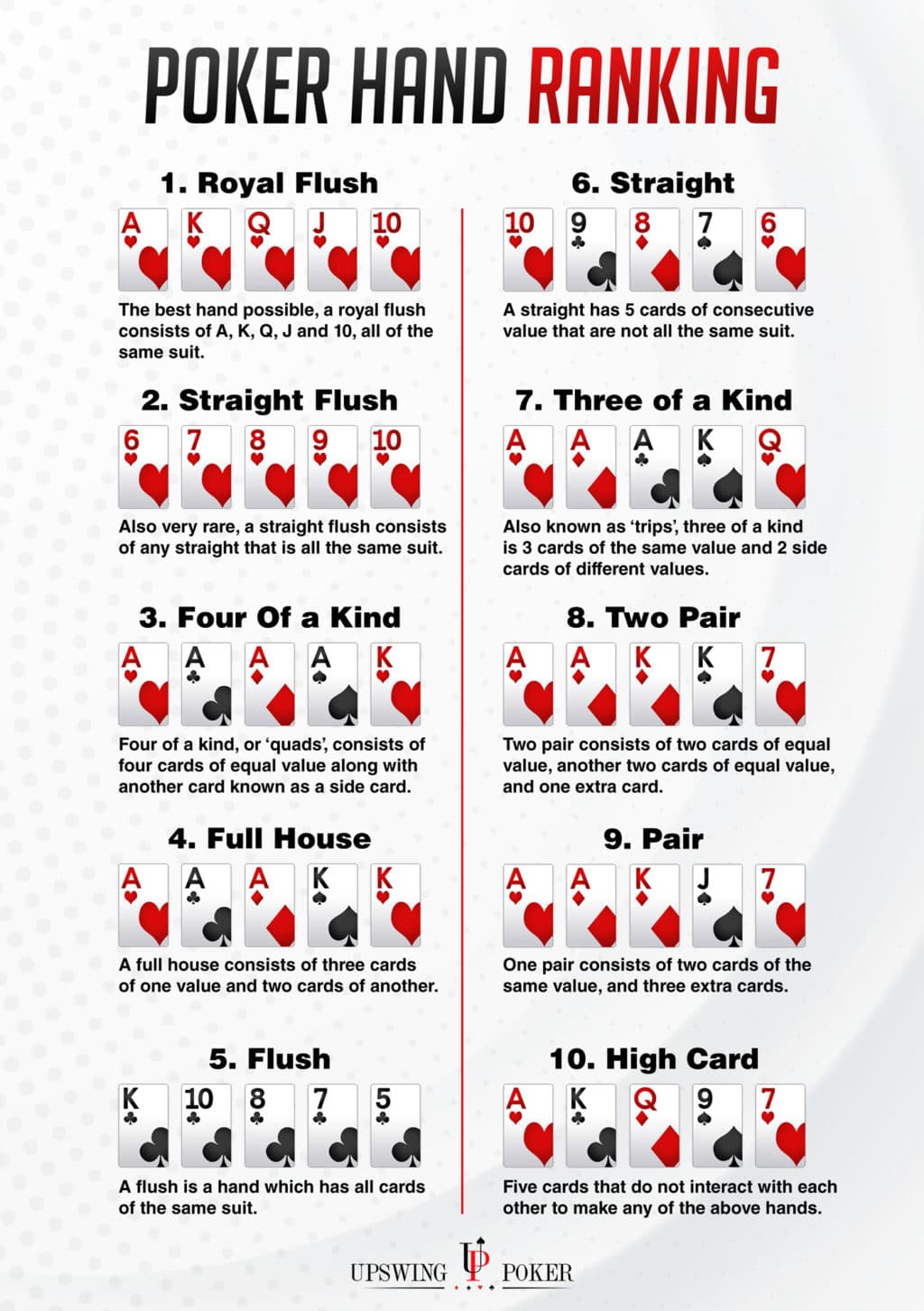
I hope you enjoyed this list of poker hands ranked!
Want to improve your overall poker strategy next? Read 10 Quick Poker Tips That Will Help Your Game.
If you prefer watching to reading, watch 5 Tips To Win A LOT More Money at Poker:
